Investigative
Reporting
Award
The climate disgrace of Visp
published by Das Magazin, Tages-Anzeiger, Tamedia-Newsgroup, Switzerland
An inconspicuous cuboid, the size of an apartment block. The cube is situated in Visp, a few metres from the Rhone, and belongs to the chemical company Lonza. It houses the most climate-damaging factory in Switzerland.
D29 is the name of the building in the Lonza factory plan. The factory produces two things: the food additive niacin; and nitrous oxide (laughing gas) as a waste product. 1800 tons of this escape from D29 every year.
Nitrous oxide is odourless – and it is not toxic. It contributes, however, more to global warming than many other greenhouse gases. Nitrous oxide is about twelve times more harmful to the climate than methane and about three hundred times more harmful than CO2.
The nitrous oxide from D29 has a greenhouse effect of about 550,000 to 600,000 tons of CO2 per year. It accounts for over one percent of Switzerland’s total climate gas emissions. An incredibly high proportion for a single factory.
D29 emits as much greenhouse gas per year as all the traffic in Switzerland during fourteen days. Or as much as eight passenger planes in permanent flight. Or as much as the city of Lucerne with all its households, all its traffic, industry and agriculture.
Nitrous oxide does not only accelerate climate change. As it decomposes in the stratosphere, it attacks the ozone layer. Of all the gases released by humans, nitrous oxide is the biggest ozone killer today.
One thing, above all, is astonishing about the nitrous oxide escaping from the Lonza plant though: until recently, no one knew it existed.
On 10 February this year, the Federal Office for the Environment sent out a media release: “Greenhouse gas emissions of the Swiss industrial sector higher than assumed”. The industry emits around 600,000 tons of CO2 equivalents more per year than previously known. The cause is a nitrous oxide source from the production of Lonza AG in Visp. The company detected the nitrous oxide in spring 2018 and subsequently reported it. The Federal Office for the Environment assumes that the nitrous oxide has been escaping from D29 for almost fifty years.
The news was briefly covered in the media. “Swiss climate balance worse than believed”, headlined the Tamedia portals. “Correction of the climate balance”, reported SRF. Then it went quiet around D29.
How is that possible? How is it possible that a global leader in the chemical industry, which presents itself as a trailblazer of a green industry, does not notice for years that thousands of tons of greenhouse gas are rising into the sky from its factory? That the environmental authorities in Valais also overlook the nitrous oxide, even though they monitor the exhaust gases in the Lonza plants? That even at the federal level no one takes notice for a long time, despite ever stricter environmental and climate laws?
Above all, how is it possible that after the problem became known, no one acted and stopped the emissions quickly?
Over the past seven months, I have tried to answer these questions. I have spoken to more than two dozen experts in organic chemistry, climate physics, environmental protection, and environmental law. I have interviewed former employees of D29. I have studied chemical literature and, based on the Public Disclosure Act, inspected internal Lonza and federal documents.
The research shows how Lonza and the Federal Office for the Environment dragged the problem out. How Lonza hid the nitrous oxide emissions from the public and shareholders for almost two years. How Lonza refused to bear the costs of neutralising the nitrous oxide itself. And how the federal government stroke a deal with Lonza that was extremely favourable for the company – a deal at the expense of the climate.
The wonderful vitamin from Visp
Autumn 1971
This story begins in autumn 1971 with the opening of the D29 factory, at that time known as the Niazol building. It is a milestone for Lonza. Since the 1950s, the company in Upper Valais has been producing synthetic niacin, a food additive that stimulates the metabolism and is also known as nicotinic acid or vitamin B3. Many people take artificial niacin every day, for example as a component of a vitamin preparation or in cereals.
With the production capacities of D29, Lonza became the world market leader for niacin all at once in 1971. The corporation has remained so to this day. In Visp and in Nansha in southern China, it produces around 35,000 tons of the powder annually, achieving an estimated 300 million dollars in sales per year. Niacin is one of the most commercially important substances in Lonza’s history. A wonderful vitamin from Visp.
Lonza has steadily refined niacin production. The researchers are especially proud of their ecological advances: In 2000, for example, a Lonza engineer described a new oxidation process in a technical article. It was more efficient in terms of CO2 emissions, heat, and waste products. “This process shows how serious Lonza is about combining economic and ecological principles in its process management”, the report stated.
Five years later, a Lonza scientist spoke about sustainability at a symposium of the Swiss Chemical Society. Niacin production had been “further developed and optimised over more than fifty years to the present day in terms of economic efficiency, product quality and ecology”, the script reads.
Lonza also presented itself internationally as a pioneering company in sustainable niacin production. In a teaching material on “Green Chemistry”, a Lonza researcher wrote in 2011: The key to environmentally friendly chemistry is “that there needs to be an awareness of all aspects of the process”.
And suddenly there is nitrous oxide
26 April 2017
Then came 26 April 2017. On that day, Lonza carried out a routine check for toxic nitrogen oxides in D29. The results made the technicians wonder. The measuring device showed a nitrogen oxide concentration that was twice as high as usual. The technicians had only one explanation for the enormous deviation: they had used a new measuring method. Upon closer examination, they found nitrous oxide (laughing gas) in rough quantities.
Why did Lonza only discover the nitrous oxide in 2017? And why did the environmental authorities of the canton of Valais and the federal government not notice it either? The answer is relatively simple: Lonza did not need to see the nitrous oxide. The others couldn‘t see it. In a way, nitrous oxide is a blind spot in Switzerland’s environmental law.
A substantial part of our environmental legislation dates to the 1980s. At that time, politics was not primarily concerned with the climate, but with protecting people, animals, and local habitats from toxic substances. As nitrous oxide is not directly toxic, it remained unregulated.
Nothing has changed in this regard until today. Although Switzerland has committed itself to reducing greenhouse gas emissions by signing the Kyoto Protocol, there are neither limits nor control obligations for nitrous oxide.
Former employees of D29 told “Das Magazin” that they had been aware that nitrous oxide was produced during niacin production, but that they had assumed very small amounts. The assumption was never checked, as nitrous oxide is non-toxic. Lonza’s official justification is very similar: nitrous oxide emissions are harmless to health and are not regulated in the Air Pollution Control Act, the company wrote in a media release in February 2020. Therefore, “no investigations into nitrous oxide were carried out in the context of niacin production”.
For the same reason, the Valais environmental authorities overlooked the gas too. The cantonal environmental office only checks industrial plants for those substances that are regulated in the Air Pollution Control Act. Nitrous oxide is not one of them.
What about the federal government? It does maintain measuring stations in Davos and on the Jungfraujoch that could have registered the nitrous oxide from D29, but there, too, nothing was detected. Experts suspect that the mountain peaks in the Upper Valais shielded the released gas from the measuring stations.
So D29 kept on producing. Niacin. And nitrous oxide.
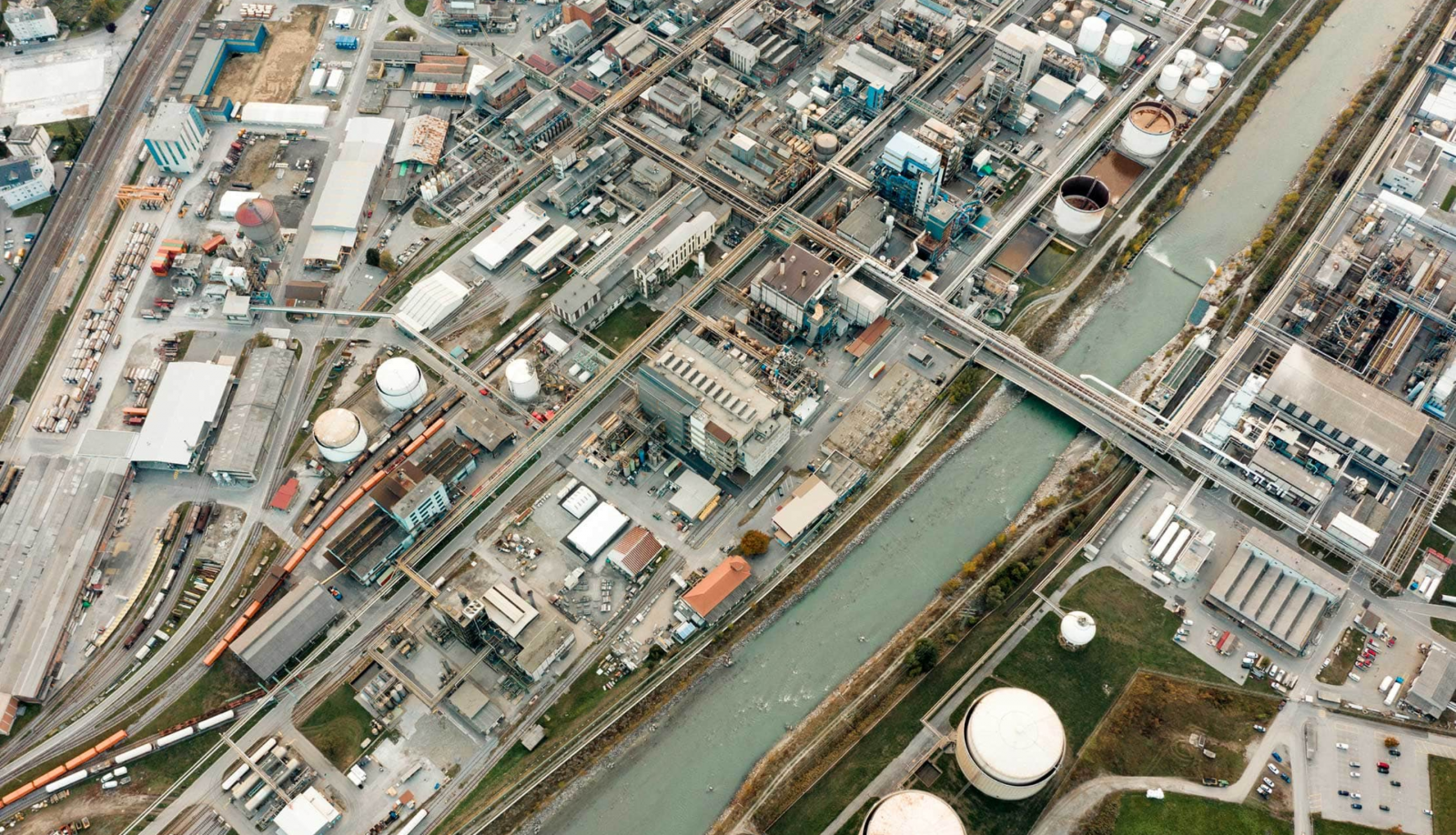
The most climate damaging factory in Switzerland: Factory D29 emits 1,800 tons of nitrous oxide every year.
Photo: Fabian Hugo
The solution: a catalyst
Spring 2018
After the first measurements in April 2017, Lonza failed to inform the authorities. Instead, it examined the exhaust gases from D29 itself and commissioned an external company to carry out a measurement. This took place on 10 April 2018. Almost a year had passed since the first indications of nitrous oxide.
Although nitrous oxide is a much more potent greenhouse gas than CO2, it plays only a minor role in the public climate debate. The main reason: nitrous oxide is less significant in terms of quantity than CO2 and methane. In addition, climate policy starts where emissions can be easily reduced. A large part of man-made nitrous oxide does not fall into this category. It is produced in agriculture when nitrogen fertilisers are used. The gas rises from the soil and can hardly be captured.
The situation is different when nitrous oxide is produced in concentrated form, for example in the industrial sector. Catalysts can neutralise the gas almost completely. They convert the extremely climate-damaging nitrous oxide (N2O) into nitrogen (N2) and oxygen (O2). Nitrous oxide becomes air.
Lonza is familiar with these catalysts. After the discovery of the emissions in D29, the company is planning to install a model from ThyssenKrupp in spring 2018. This could reduce emissions by more than 98 per cent, according to an internal document. Instead of 5 tons of nitrous oxide per day, D29 would then only emit around 75 kilograms.
The catalyst could be effective from the third quarter of 2019, writes Lonza in 2018. The costs amount to CHF 12 million, a manageable sum for a corporation with an annual turnover of 6 billion. Nevertheless, until today there is no sign of a catalytic converter in Visp. The reason: Lonza did not want to pay for the installation itself.
Lonza informs the federal government – and wants money
25 May 2018
On 25 May 2018, a Lonza delegation enters the headquarters of the Federal Office for the Environment in the Bernese suburb of Ittigen. The company representatives have prepared themselves well. For Lonza, it’s not just about 12 million Swiss francs, but much more money.
To lighten the mood, the Lonza representatives open the meeting with good news – a small emission reduction at the petrol cracking plant in Visp. Then they move on to D29. Here, too, Lonza emphasises the positive aspects. With a catalyst, nitrous oxide emissions from the niacin process could be greatly reduced, the meeting report says. “Lonza is planning to install a catalytic converter.”
The company representatives set only one condition: The construction of this plant must be recognised by the federal government as a CO2 offset project. Without the proceeds from the sale of CO2 certificates, the project is “not cost-efficient and will therefore not be implemented”. Thus, the company wants to be paid to stop polluting the climate. Otherwise D29 will simply continue to run.
In principle, this is nothing unusual. Much of Switzerland’s climate strategy is based on the idea that financial incentives can encourage businesses, households, and citizens to reduce their greenhouse gas emissions.
The so-called carbon offset projects also work according to this principle. Those who reduce emissions with voluntary measures can sell the CO2 savings to a foundation of the Swiss mineral oil industry. The foundation paid an average of CHF 95 per ton of CO2 reduction in 2019.
Often the investment costs are not fully covered by this contribution. Sometimes, however, the polluter of the emission even makes a profit. This was also the case with D29. Given that the plant emits so much greenhouse gas and the price of a catalytic converter is comparatively low, tens of millions of francs in profit would be in store for Lonza from selling its climate damage.
However, there was one problem: Lonza is one of the companies with the highest greenhouse gas emissions in Switzerland and, according to the CO2 Act, is not eligible for carbon offset projects at all. For companies like Lonza, a stricter set of rules applies, the so-called emissions trading system.
This system works as follows: Every year, the federal government distributes a certain number of free emission certificates to the participating companies. These certificates entitle the companies to emit greenhouse gases. At the end of the year, the accounts will be balanced. For every ton of greenhouse gas which was effectively emitted, the company must submit an emission certificate. If a company does not have enough certificates, it must buy the missing ones.
As the federal government reduces the number of free certificates issued by around two percent each year, an incentive system is created: if companies do nothing to improve their climate efficiency, they must buy more and more certificates. If, on the other hand, a company manages to reduce its emissions, it can sell the remaining free certificates of the federal government or save them for later.
Carbon offset project or emissions trading? In May 2018, this is a multimillion-franc question for Lonza. Either the company receives money from the petroleum industry’s pot to get rid of the nitrous oxide problem – or it has to fund the catalytic converter itself and also acquire emission certificates for the nitrous oxide that is escaping from D29 until the catalytic converter is installed.
In the negotiations with the federal government from May 2018 until autumn 2019, Lonza insists on being allowed to implement the catalytic converter as a carbon offset project – despite legal objections. This is a crucial reason why the nitrous oxide catalyst is still not operating.
Practically nothing happens at the federal level
Summer 2018
Another reason can be found in Ittigen, at the Federal Office for the Environment. How does an environmental authority react to the news that a huge and easily avoidable source of greenhouse gas has been discovered in its area of responsibility? One would think with immediate measures.
The opposite is the case at the Federal Office for the Environment. After 25 May 2018, the day Lonza had informed the authorities about the nitrous oxide problem, not a lot was happening. The company indeed submits an eight-page project outline for the construction of the catalytic converter as a carbon offset project as early as mid-June – but when Lonza asks about the state of affairs at the Federal Office in July, an official writes back: “Unfortunately, I can’t give you a firm date for the response.” Colleagues were “absent for holidays” until the end of July.
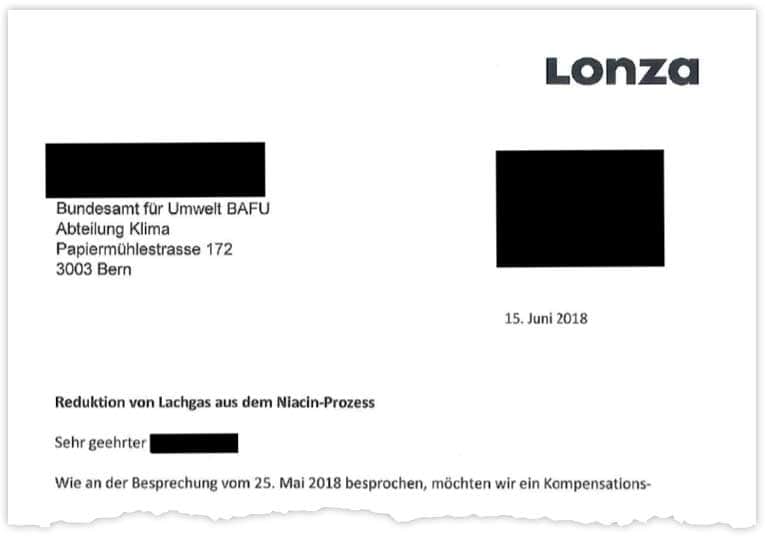
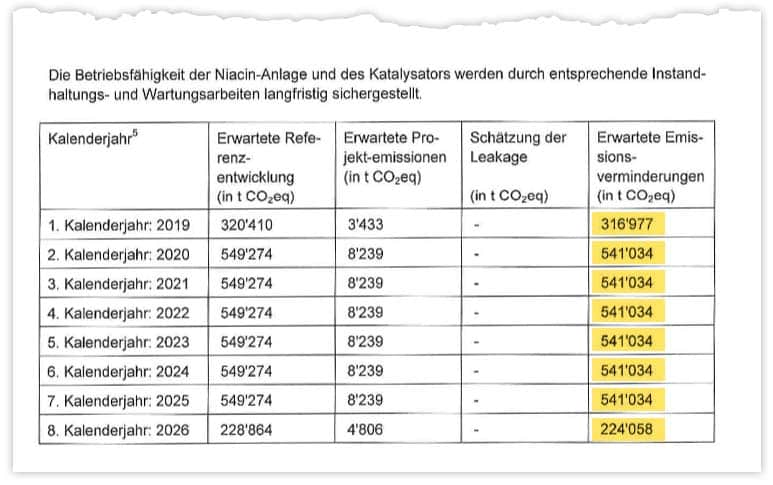
A project outline by Lonza shows that the corporation wanted to install the nitrous oxide catalyst as early as 2019. The emission of more than one million tons of CO2 equivalents in 2020 and 2021 could thus have been avoided compared to the current planning status.
When the office finally replies on 22 August 2018, it is only a “voluntary preliminary assessment”. The Federal Office for the Environment points Lonza towards the legal situation, according to which companies that are subject to the emissions trading system are not eligible for carbon offset projects. In addition, there were ambiguities in the project outline.
A few days later, Lonza asks how the ambiguities can be resolved. Again, it takes four weeks for the Federal Office to reply: It still needs to be clarified where exactly in the niacin production process the nitrous oxide is produced.
On 1 October 2018, the Federal Office for the Environment decides to have the issue clarified externally. The report arrives five months later, in March 2019, and states that the nitrous oxide is produced during niacin synthesis. This is exactly what Lonza told the federal government about nine months earlier.
There is an additional delay because the environmental authority had commissioned a second expert assessment in the meantime. It wants to know from an institute in Germany how the EU would integrate Lonza’s niacin plant into its emissions trading scheme. The short version: “There is no comparable plant in the EU.” When the report arrives, it is June 2019.
The catalytic converter is still blocked
June 2019
More than a year has now passed since the Federal Office for the Environment learned about the nitrous oxide problem in D29. In the meantime, Federal Councillor Simonetta Sommaruga of the Social Democratic Party has taken over the Environment Department in Bern and insistently called for more climate protection. A few floors down, however, the Lonza case is gathering dust.
There is deadlock over the installation of the catalytic converter. The conflict in mid-2019 is still the same as in May 2018: Lonza wants money from the pot for carbon offset projects. The Federal Office for the Environment is still brooding over the question whether this is permissible. Meanwhile, D29 just keeps on running. 5 tons of nitrous oxide per day. The equivalent of 1500 tons of CO2.
Lonza’s company history is rich in environmental scandals. Recently, however, the company has been making efforts to polish up its image. A key event was the election of Albert M. Baehny as president of Lonza. Under Baehny, the company commits to the UN climate change action in 2018. Under Baehny, a comprehensive sustainability report is produced for the first time. Under Baehny, Lonza even creates its own “Sustainability Council”. This council reports directly to the Executive Committee and it’s sole task is to strengthen the idea of sustainability throughout the corporation.
The green course remains explicitly a matter for the boss. “The ultimate responsibility for all sustainability issues lies with the Chairman of the Board of Directors,” writes Lonza at the beginning of 2019, hence with Albert M. Baehny. Baehny summarises the company’s values as follows: “We measure our success not only by sales and profits, but also by how much we can give back to our people and communities and contribute to the protection of the environment.”
In the negotiations with the federal government, however, environmental protection is not a priority for Lonza. The decisive factor is not having to pay for the installation of the catalytic converter.
The bazaar around D29 begins
26 July 2019
On 26 July 2019, just over a year after the first meeting, a delegation from Lonza arrives in Ittigen again at 8.30 am. Now the company representatives learn that a carbon offset project is definitely not possible. The objections of the legal department of the Federal Office for the Environment are too strong.
Instead, the federal government is making an offer: Lonza will pay for the catalytic converter itself but will be released from the obligation to buy emission certificates for the nitrous oxide for 2018. For 2019 and 2020, the company will further receive free emission certificates from a federal reserve. However, because the reserve is not sufficient, Lonza would have to buy additional certificates. Simonetta Sommaruga, according to the minutes, will be informed about the decision.
The offer of the environmental officials illustrates a special mixture of fantasy and formalism: According to the minutes of the meeting, the office argues that nitrous oxide was only proven by the external expert assessment of March 2019. “Legally, therefore, these are new emissions.” Therefore, Lonza mustn’t submit certificates for the period before the report. Thousands of tons of nitrous oxide – simply deleted.
Lonza does not even accept this generous offer though. On 13 August, the company complains about the “major financial impact” and asks for a transitional arrangement for the years 2019 and 2020, because it can only expect nitrous oxide emissions to be adequately considered in the distribution of the free certificates from 2021 onwards.
And Bern caves in again
4 September 2019
On 4 September, the federal government makes another compromise: Lonza does not have to submit emission certificates for 2019 either, saving up to CHF 10 million. But even that is not enough for the corporation. The legal department is increasing the pressure on the federal office, and Lonza is playing its strongest card: the 3,000 jobs in Visp. “We do not want to endanger the environment or the Visp location,” it says in a letter from 16 September 2019. However, if emission certificates for 12 million francs must be bought for 2020, “a relocation of niacin production to China is also being considered, which would threaten jobs in Visp. A relocation would weaken the industrial location as a whole, even threaten it.”
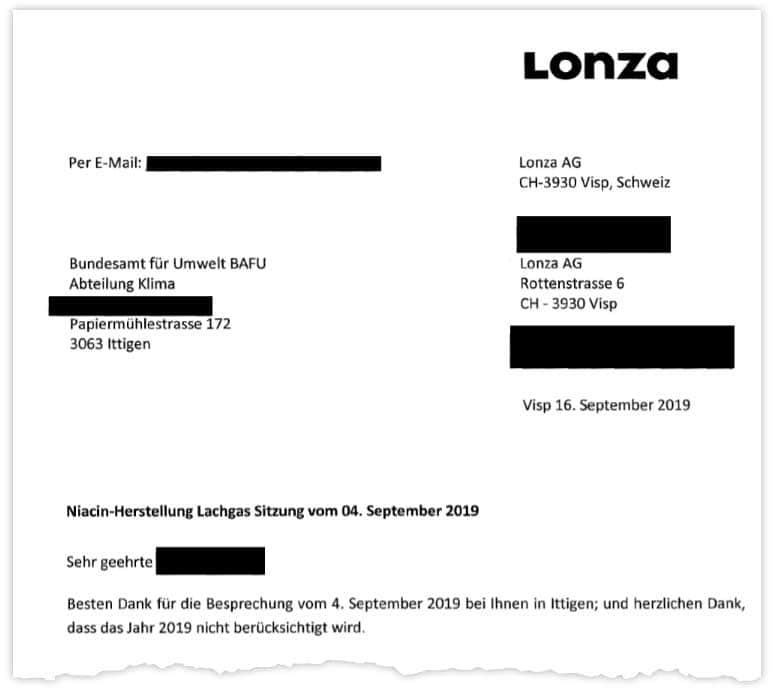

“Visp location threatened”: Lonza fought with no holds barred for the Federal Office for the Environment to concede.
The threat works. On 13 November 2019, the two parties agree that Lonza will not have to buy any emission rights on the stock exchange for the 1800 tons of nitrous oxide in 2020. Instead, the group receives free emission rights from the federal government, part of them as an advance for 2021. In return, Lonza commits to “put the combined catalytic converter into operation by the end of 2021 at the latest”.
In other words: D29 may continue to run for two years. The Federal Office for the Environment is thus condoning additional emissions of 1.2 million tons of CO2 equivalents.
The federal office and the question of cost
September 2020
Why didn’t the office act more quickly? Why didn’t it push for a quick solution? Andrea Burkhardt, the head of climate at the Federal Office for the Environment, sits in a cramped meeting room at the agency’s headquarters at the end of September 2020. She is defending herself against the accusation that she has dragged out the nitrous oxide problem. It is true that the two expert reports took a lot of time, Burkhardt says. But firstly, it had to be established beyond doubt where the nitrous oxide is produced in the niacin production process. “That was a prerequisite for submitting the emissions to the emissions trading system.”
Secondly, the federal government had to protect itself in case the dispute with Lonza ended up in court. “Then it would have probably taken much longer for the catalytic converter to be activated.”
But why didn’t the authorities put more pressure on the company? “We checked whether we could oblige Lonza to install the catalytic converter immediately,” says Burkhardt. “But there is no legal basis for this because nitrous oxide is not regulated in the Air Pollution Control Act.” To find a quick solution anyway, she says, Lonza was waived the emission rights for 2018 and 2019. “It wouldn’t have done anyone any good if Lonza had bought them on the market. It would have only occasioned costs,” says Burkhardt.
The fact that these costs would have been a means of motivating Lonza to build the catalytic converter quickly too is ignored at the Federal Office for the Environment.
How Lonza and the Federal Government hid the nitrous oxide
2018 until 2020
There is probably another reason why the nitrous oxide problem in Visp was not tackled more firmly: The public, the environmental associations, the Parliament, even the shareholders of Lonza, all those who could have exerted pressure, were kept in the dark all this time.
Although Lonza already knew in spring 2018 how much nitrous oxide escapes from D29, the emissions were concealed for almost two years. In March 2019, the corporation presented shareholders with incorrect figures on the company’s greenhouse gas emissions – the nitrous oxide was simply omitted. The effect is remarkable: The actual direct emissions were around twice as high as those reported by Lonza in the 2018 annual and sustainability report.
In the new sustainability report published this year, Lonza writes that nitrous oxide emissions were only “quantified in 2019”. However, documents obtained by “Das Magazin” show that this is not true. The measurements already took place in 2018.
Incorrect information in annual reports can weaken shareholder confidence and force institutional investors to take action. The Lonza share is an important position in many sustainability funds of Swiss banks (e.g. UBS, Raiffeisen, Vontobel, Basler Kantonalbank). Some of these sustainability funds made significant additional purchases of Lonza shares in the year of the misreported issue figures. These funds could come under pressure from investors now.
Even the Federal Office for the Environment helped with the concealment: Large industrial companies are obliged to enter their pollution rate in the Swiss pollutant register. Although Lonza informed the authorities in May 2018 about the emission of around 1800 tons of nitrous oxide per year, the company only had 25 tons entered in the register that year.
The Federal Office for the Environment, which is responsible for enforcing the compulsory reporting, had tolerated this: At the time, the quantity had not yet been proven beyond doubt, the office explains.
Even more delay for the catalytic converter
October 2020
What does Lonza President Albert M. Baehny say about the most climate-damaging factory in Switzerland though? Why did the corporation conceal the emissions from D29? Why didn’t Lonza speed up the construction of the catalytic converter? And how does all of this fit in with the company’s commitment to environmental and climate protection?
I would have liked to address these questions personally to Albert M. Baehny – but the press office told me that it was not possible to talk to the Lonza Chairman. Instead, the company sent a written statement from Baehny.
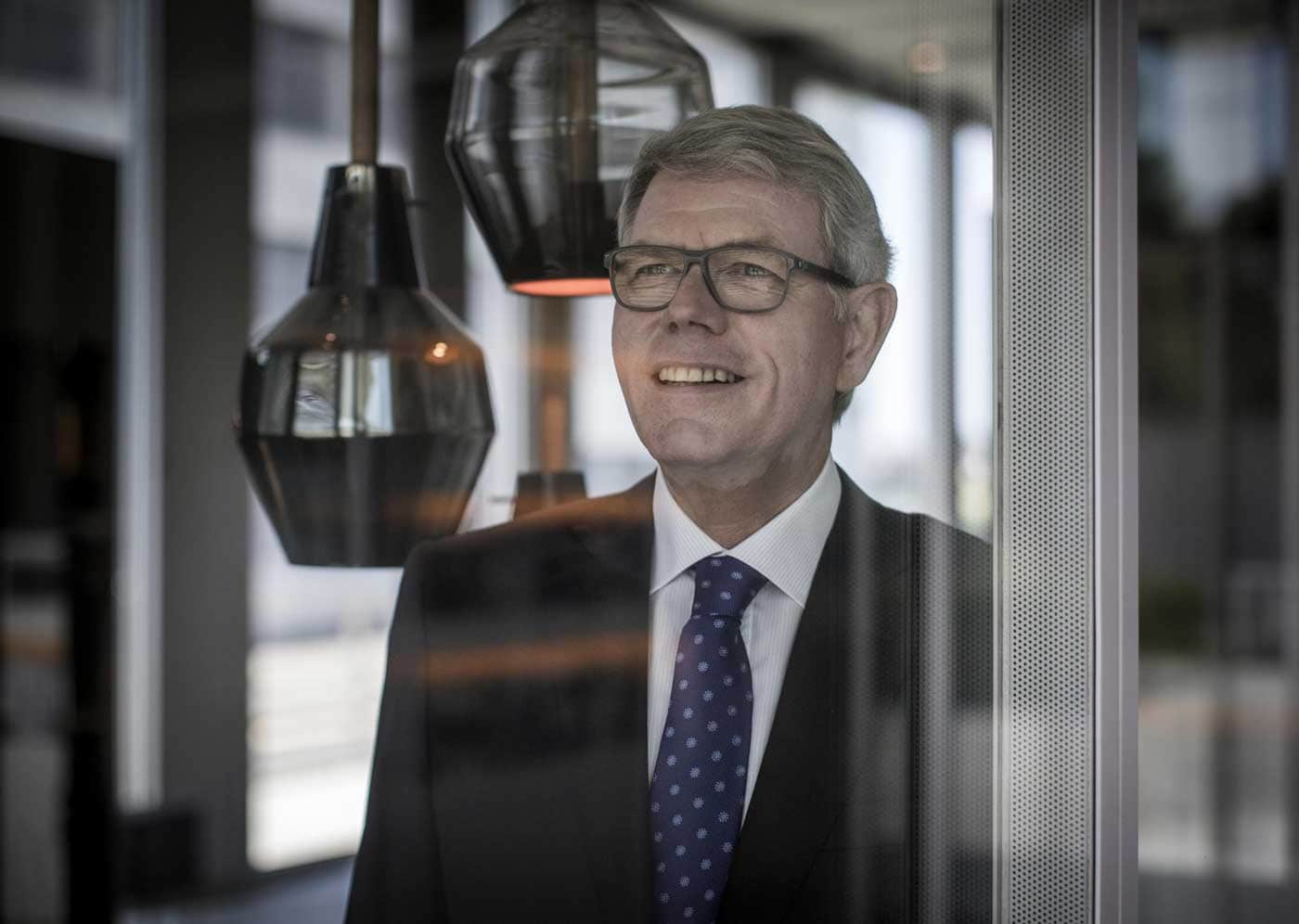
Lonza President Albert M. Baehny said that his group was working “at full speed” on the technically sophisticated catalyst solution.
Photo: Kostas Maros (Bilanz)
According to Baehny, Lonza did not make any mistakes, neither before 2017 nor afterwards. The letter does not even express any regret that so much time has passed before the catalytic converter is installed. Rather, it states that it’s only thanks to Lonza that the emissions from D29 are known at all today: “I remind you of the fact that it was Lonza that became aware of the nitrous oxide issue and that it was Lonza that made the issue transparent to the federal government and the public.” In addition, he said, the company strives to minimise emissions “even if there are no regulatory limits to comply with”.
He does not want the fact that Lonza had presented the prospect of relocating niacin production to China to be understood as a threat. For such projects, it is “quite usual to examine various options”. Lonza was not responsible for the fact that the implementation of the catalyst has been delayed for years. The company had worked “at full speed” on the demanding technical solution. A building permit had to be obtained too. The plans for commissioning in the third quarter of 2019 “proved to be too optimistic”.
The announcement in February 2020 that the catalyst would be ready by August 2021 was also too optimistic. Lonza will not meet the deadline of the end of 2021 that was agreed upon with the federal government. Implementing the catalyst is now planned for the first quarter of 2022. But not even that is certain: According to the Lonza press office, the “caveat” of met deadlines by the suppliers applies.
Thus, almost five years will have passed from the first indications of nitrous oxide to its neutralisation. Almost 9000 tons of nitrous oxide have been produced by D29 during this time. The equivalent of 2.7 million tons of CO2. And all because of a tiny loophole in the law, a sluggish environmental authority and a company that did not want to pay for the catalytic converter neutralizing the climate gas it has been producing.






